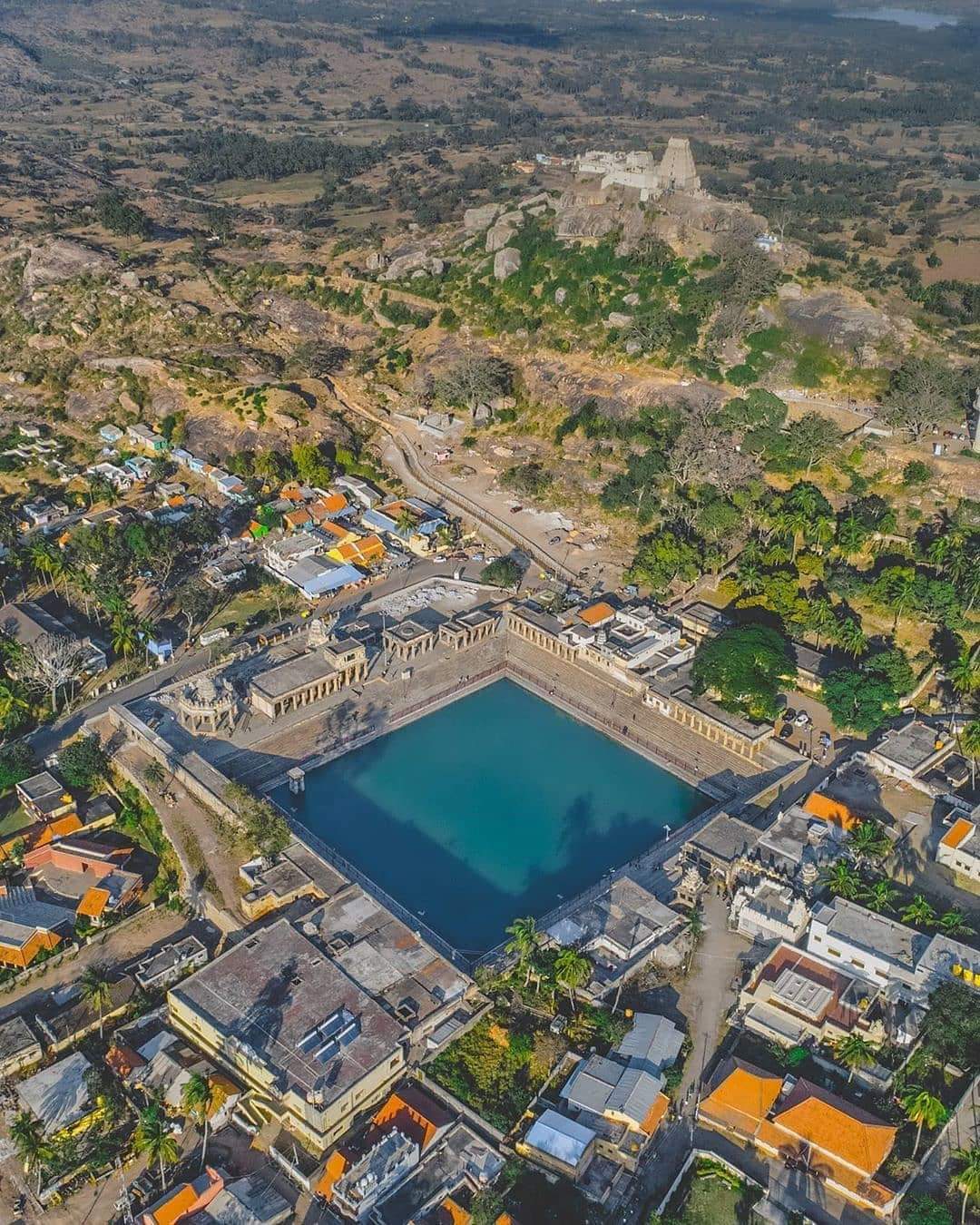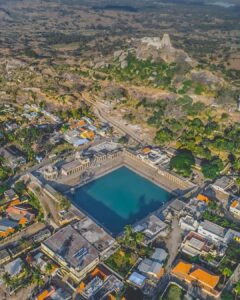
Melkote is a sacred place located in the Pandavapura Taluk of Mandya district in the Karnataka. Also known as Thirunarayanapuram, it is the second home of Swami Ramanujacharya. It has been the tapo bhumi of Bhakta Prahlada and the sacred sporting site of Sri Sita Ramachandra. With the so-called advancement of civilization, Melkote still remains a traditional heritage village in India.
Once in the year 2011 much before the inception of Tirtha Yatra, I had a sincere desire to witness the nirmalya darshan of Sri Thirunarayana Swamy. The Lord admitted me to His sacred abode to be part of His wedding. In the mid of the rainy season, surrounded by the temple bells, the chanting of the Vedic Mantras such as Purusha Sukta, the gravity of Vaishnavas’ faces, the entire town of Melkote wore a look which was beyond the imaginary pleasures of heaven. It was as though the house of the Lord has been rendered service by Indradev to get it washed and decorate it.
The rituals of Kalyanotsava commenced in such a spiritually surcharged environment. I witnessed the nirmalya darshan of the Lord which was like the mangala-snana of the groom before wedding, the wedding of the Lord which was conducted in the mukha-mantapa opposite to Lakshmi Devi’s altar is still fresh in my mind.
The Yoga Narasimha Temple and the Thirunarayana Swamy Temple constitute the main sacred attractions which have been built on the Yadugiri Hills. These hills are also called Yadavagiri, Yati Shaila overlooking the Cauvery Valley. Melkote is also home to many other temples and sacred ponds. Sri Ramanujacharya spent 12 years here before moving back to Sri Rangam. He established the first of his three deities i.e. Sri Ramanujacharya’s deities by himself here before moving to Srirangam so that his disciples would never feel his absence.
Vedic History of Melkote
The Vedic History goes as far as the Satya Yuga. It has been referred to in the scriptures such as the Naradiya Purana, Kashi Mahatmya, Matsya Purana and the Ishwara Samhita.
Being associated with Lord Narayana, the Melkote Hill was called Narayanadri in the Satya Yuga. In the Treta Yuga, the hill came to be known as Vedadri because Lord Dattatreya taught Vedic knowledge to His disciples here. Great devotees such as Prahlada and Medhatithi studied the Vedas here under the guidance of Lord Dattatreya. In the Kali Yuga, the sacred hills got the name Yati Shaila as Sri Ramanujacharya revived this sacred town and the hills in the 11th century. All the deities worshipped on this sacred hill have been consecrated by great devotees of Lord Narayana such as Prahlada, Sanatkumara, etc originally.
There are two main temples here. One is the temple of Lord Thirunarayana where the Utsavar deity of Lord Cheluvanarayana (Ramapriya) is also worshipped. The other is the temple of Lord Yoga Narasimha. Both of them have transcendentally beautiful lilas connected to their appearance. Lord Yoga Narasimha appeared due to the hard penances performed by His great devotee Bhakta Prahlada atop this sacred hill.
Ramapriya through The Yugas
In Satya Yuga, Sri Sanatkumara, one of the four Kumaras and the exalted son of Lord Brahma consecrated the Deity of Lord Thirunarayana atop the Melkote Hill after receiving it from Lord Brahma. In the Treta Yuga, the Cheluvanarayana Deity, the Utsavar deity of Lord Thirunarayana was worshipped by Lord Rama after receiving it from Lord Brahma. It finally reached Melkote in Dwapara Yuga, brought there and consecrated by the lotus hands of Lord Krishna.
In the 11th century of the Kali Yuga, Sri Ramanujacharya restored and revitalized those temples which were destroyed and looted during the attack of the Islamic barbarians. He had to shift himself from Srirangam to a place called Thondanur nearby after the Chola king ruling the region started harassing the devotees of Lord Vishnu.
He found the lost deities of Thirunarayana and Cheluvanaraya, got the temples constructed for them and arranged for their grand worship. In a span of just 12 years, he developed Melkote into a Vedic hub with arrangements for learning and other activities.
Contributions of Sri Ramanujacharya & Others in Melkote
As per the Paushkara Samhita, Sri Ramanujacharya made four kinds of endowments towards the development of Melkote into a Vedic hub. They are –
- Alaya Pratishthana: Temple construction.
- Brahma Pratishthana: Establishment of a colony of brahmanas (mainly priests) around the temple.
- Vidyapitha Patashala: Establishing a Vedic school in the temple precincts.
- Phala-Mula Pratishthana: Establishing agricultural accessories for temples; building lakes and wells to provide enough water for the agricultural lands under the temple.
Melkote is referred to as Jnana Mandapa due to the vast facilities established there for Vedic learning. Mummadi Krishnaraja Wodeyar, the king of Mysore established the Vedavedanatabodhini Samskrita Mahapathasala here in 1854 CE. Another important centre of learning was the Sri Ubhaya Vedanta Pravartana Sabha established in 1902 CE to teach Sanskrit and Tamil texts.
The Kalyani Pushkarini here is very much sacred with a history spanning thousands of years. It is said to have formed from a few drops of water which fell on the Melkote Hill when Lord Varaha took the earth out from the causal ocean, as per the Ishvara Samhita. It is mentioned in other puranas such as the Padma Purana, Matsya Purana, etc too.
Sacred places of Melkote
- Paridhanashila Kshetra: Located on the sacred banks of the Veda Pushkarini pond, Lord Dattatreya taught the Vedas to His students here. Sri Ramanujacharya gave up his white robes for saffron robes here.
- Yoga Narasimha Kshetra: Bhakta Prahlada received the deity of Lord Yoga Narasimha here on the top of the hill.
- Dhyana Ashwattha Kshetra: Located by the west bank of Kalyani Pond, the five great intellectuals Bhakta Prahlada, Sage Shuka, Ambarish Maharaj, Rukmangada and Pundarika attained brahman realization here.
- Taarkshya Kshetra: A sacred place near the Kalyani Pond where the white sand brought by Garudadeva from Shwethadwipa is stored on the orders of Lord Vishnu.
- Nayana Kshetra: Located in the row of hills near Yadugiri, a brahmana by the name Vishnuchitta performed austerities here. The deity of Lord Keshava is also present here.
- Varaha Kshetra: Located by the east bank of the Kalyani pond, this is where Lord Varaha taught the essence of Vedic knowledge to Bhu Devi while She was seated on the Lord’s lotus lap.
- Seeta Aranya Kshetra: Located on the southern entrance of the Kalyani pond, this is where Lord Rama stayed in Melkote along with Sita Devi and Lakshmana.
- Veda Pushkarini: The sacred pond on whose banks Lord Dattatreya taught the Vedas.
- Yadava Tirtha: The Yadavi river flows by the side of this pond. A king named Yadavendra attained liberation on its banks.
- Palasha Tirtha: A sacred pond surrounded by Palasha trees. The sons of Sage Vasishtha were released from the curse of Sage Vishwamitra by bathing in its sacred waters.
- Darbha Tirtha: Lord Dattatreya used the Darbha grass grown on its banks for yagnas, homas and other Vedic activities. Sage Shandilya spoke about the Pancharatrika system of worship at this place.
- Padma Tirtha: Sanatkumara, the great devotee and son of Lord Brahma used the lotus flowers from this sacred pond for worshipping Lord Thirunarayana.
- Maitreya Tirtha: Also known as Parashara Tirtha, as Sage Parashara spoke the Vishnu Purana to Sage Maitreya at this place.
- Narayana Tirtha: Lord Narayana blessed a brahmana called Vishnuchitta here in Nayana Kshetra.
- Vaikuntha Ganga: A sacred pond formed from a single sacred drop of the sacred and famous Viraja River which flows in Vaikuntha.
- Dhanushkoti Sita Kunda: Lord Rama shot His arrows here into a rock to bring out water for Sita Devi to bathe.
How to Reach Melkote
After knowing all this, you would definitely love to explore Melkote if you have never done so. Or else, if you have gone there earlier, you may want to explore the unexplored. In such scenarios, Tirtha Yatra is highly recommended.
Melkote stills lies in an unspoilt location. There are good transportation options in light of the demand of devotees travelling there. You would never have trouble reaching there –
By Road: State bus services are available from Mysuru, Mandya, Pandavapura and K R Pet frequently. Or you could catch a state bus from Bengaluru to Pandavapura/Mandya and then hire a taxi. If you intend to travel by your own car, cab or self-driven car, the route from Bengaluru/Mysuru is a smooth one via SH17.
By Rail: Pandavapura Railway Station (PANP) 27 km away is the nearest station followed by Mandya Railway Station (MYA) 40 km away. There are regular trains from KSR Bengaluru Railway Station (SBC) to Pandavapura and Mandya. Further on, you can hire a taxi after alighting. KSRTC buses are available from these places too.
From other cities/ towns across India, you can board a train to Mysuru or Mandya and proceed further.
By Air: Kempegowda International Airport in Bengaluru 169 km away and Mysore Airport approx. 65 km away are the nearest. While Mysore Airport serves a limited number of domestic destinations, the Bengaluru Airport serves many international and domestic destinations.
2











2 Comments On Melkote
Kala murthy
If you are planning a trip to melkote pls infm me also.
harikirtan
planning to visit please share or advise your itenary
in january 28 around 15 devotees cplanning.